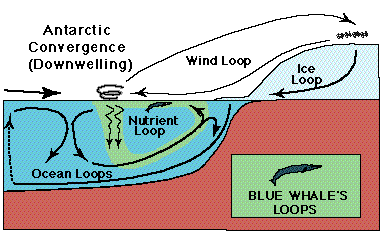
I told the story of the Blue Whale to show off some of Nature's greatest
loops, and to illustrate how loops are connected to one another. Earth-size
loops, working together, entrained in one another bring to our planet a
harmony and stability which has persisted through geologic time. These examples
help us recognize and appreciate loops on a smaller scale, those which effect
us directly.
Here is a quick summary of the loops in the Blue Whale story, in the order
in which they appeared. Some figures and discussion have been added to complete
the picture.
Nutrient Loop
A universal loop for all life forms. This loop is essentially the same as
the Ecosystem Loop, which transfers nutrients and non-living to living systems
and life forms, and then back to the non-living and inorganic materials.
The ecosystem or nutrient loop is balanced between two energy sources 1)
gravity, which acts to physically break down and separate the living from
the non-living, and 2) solar or chemical energy, which reorganizes inorganic
materials into life forms. In the story, the nutrient loop is entrained
in ocean circulation.
Ocean Circulation Loop
The Blue Whale story told only of ocean water sinking near the Antarctic
coast and rising again in the area farther from shore. The ocean loops which
drive upwelling around Antarctica are more complicated. For example, the
wild katabatic winds which come down off the ice cap blow offshore and push
the surface water away from the coast, causing nutrient rich water to rise
in its place.

Antarctic Bottom Water, generated near the coast, flows along the bottom,
far to the north, even across the equator, and eventually is replaced by
water returning at intermediate depth. It is estimated that a round trip
for a molecule of water could take as long as 1000 years. Westerly winds
blowing to the southeast drive a surface current which moves water toward
Antarctica. Where the two wind streams and surface currents meet, in the
Antarctic Convergence, ocean water sinks in a zone of downwelling.